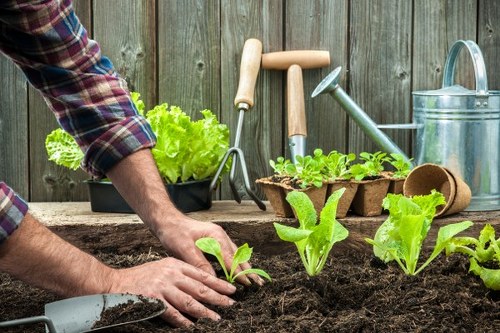Tree Lopping and Removal in Garden Maintenance

Maintaining a healthy and aesthetically pleasing garden involves various tasks, one of the most crucial being tree lopping and removal. Whether you’re looking to preserve the safety of your property, enhance the beauty of your landscape, or ensure the overall health of your trees, understanding the importance and techniques of tree maintenance is essential.
Tree lopping refers to the selective removal of specific parts of a tree, such as branches, to improve its structure, health, and safety. On the other hand, tree removal is the complete extraction of a tree from its location, which might be necessary due to disease, structural damage, or other significant reasons.
Effective tree maintenance not only contributes to the visual appeal of your garden but also plays a significant role in the environmental well-being of your surroundings. Properly maintained trees provide shade, improve air quality, and contribute to the overall ecosystem of your garden.
Understanding Tree Lopping

Tree lopping is a vital practice in garden maintenance that involves the trimming and pruning of trees to promote healthy growth and prevent potential hazards. This process helps in shaping the tree, removing dead or diseased branches, and ensuring that the tree remains structurally sound.
There are several reasons why tree lopping is necessary:
- Safety: Removing hazardous branches reduces the risk of accidents during storms or high winds.
- Health: Pruning eliminates diseased or infested branches, promoting healthier growth.
- Aesthetics: Shaping the tree enhances the overall look of your garden.
By regularly lopping your trees, you ensure that they grow in a controlled manner, preventing them from becoming unruly or causing damage to nearby structures.
When to Consider Tree Removal

While tree lopping is beneficial, there are instances where complete tree removal becomes necessary. Recognizing these situations is crucial for maintaining the safety and health of your garden.
**Key indicators that a tree may need to be removed include:
- Severe Disease or Decay: Trees afflicted with significant disease or decay may pose health risks to other plants and structures.
- Structural Damage: Trees with compromised structures are more susceptible to falling, especially during adverse weather conditions.
- Obstruction of Utilities: Trees that interfere with power lines, pathways, or buildings may need to be removed to ensure safety and functionality.
In such cases, professional assessment and removal are recommended to mitigate safety hazards effectively.
Techniques for Effective Tree Lopping

Applying the right techniques in tree lopping is essential for the health of the tree and the safety of your garden environment. Here are some effective methods used by professionals:
- Crown Thinning: Removing selected branches to increase light penetration and air circulation within the canopy.
- Deadwooding: Eliminating dead or diseased branches to prevent decay and pest infestations.
- Heading Cuts: Shortening branches to encourage the growth of new shoots and improve the tree's shape.
Using these techniques judiciously ensures that the tree remains healthy and aesthetically pleasing, without causing undue stress or damage.
Tools and Equipment for Tree Maintenance

Proper tools and equipment are vital for effective tree lopping and removal. Investing in quality tools not only makes the process more efficient but also ensures safety during operations.
**Essential tools include:
- Pruning Shears: Ideal for trimming small branches.
- Chainsaws: Necessary for cutting larger branches and trunks.
- Loppers: Suitable for medium-sized branches that are out of reach.
- Safety Gear: Protective helmets, gloves, and eye protection to ensure personal safety during the operation.
Ensuring that all tools are well-maintained and sharp enhances efficiency and reduces the risk of accidents.
Safety Considerations in Tree Removal

Tree removal involves inherent risks, making safety a paramount concern. Whether you’re performing the task yourself or hiring professionals, adhering to safety guidelines is crucial.
**Key safety considerations include:
- Assessing the Tree's Condition: Understanding the tree’s health and structural integrity helps in planning the removal process.
- Securing Permissions: In some regions, permits may be required for tree removal, especially for protected species.
- Using Proper Equipment: Ensuring that all tools and machinery are in good working condition and appropriate for the task.
- Safety Gear: Wearing protective clothing to prevent injuries from falling branches or debris.
By prioritizing safety, you minimize the risk of accidents and ensure a smooth tree removal process.
Choosing the Right Professionals for Tree Services

Selecting qualified and experienced professionals is essential for effective tree lopping and removal. Here’s what to look for when hiring tree care services:
- Certification and Licenses: Ensure that the arborists are certified and licensed to perform tree services in your area.
- Experience: Experienced professionals are more likely to handle complex tree removal tasks safely and efficiently.
- Insurance: Proper insurance protects you from liability in case of accidents during the tree removal process.
- Reputation: Check reviews and testimonials to gauge the quality of service provided by the company.
Choosing the right professionals ensures that your tree maintenance needs are met with expertise and reliability.
Cost Factors in Tree Lopping and Removal

The cost of tree lopping and removal can vary based on several factors. Understanding these can help you budget effectively for garden maintenance.
**Factors influencing cost include:
- Tree Size: Larger trees require more labor and time, increasing the overall cost.
- Location: Trees that are difficult to access or near structures may cost more to remove safely.
- Health of the Tree: Diseased or decayed trees may require additional care and specialized equipment.
- Additional Services: Cleanup, stump removal, and hauling away debris can add to the total cost.
Getting a detailed estimate from your tree service provider helps in understanding the breakdown of costs and planning accordingly.
Environmental Impact of Tree Removal

While tree removal may sometimes be necessary, it’s important to consider its environmental impact. Trees play a crucial role in maintaining ecological balance, and their removal can have significant consequences.
**Environmental considerations include:
- Loss of Habitat: Trees provide shelter and food for various wildlife species.
- Carbon Sequestration: Trees absorb carbon dioxide, helping to mitigate climate change.
- Soil Erosion: Tree roots help in preventing soil erosion and maintaining soil health.
Whenever possible, explore alternatives to removal, such as pruning or transferring the tree, to preserve its environmental benefits.
Benefits of Regular Tree Maintenance

Regular tree maintenance, including lopping and removal when necessary, offers numerous benefits for your garden and property.
**Key benefits include:
- Enhanced Safety: Preventing hazardous tree conditions reduces the risk of property damage and personal injury.
- Improved Tree Health: Regular maintenance promotes the overall health and longevity of your trees.
- Increased Property Value: A well-maintained garden with healthy trees enhances the aesthetic appeal and value of your property.
- Energy Efficiency: Strategically placed trees provide shade, reducing cooling costs in summer.
Investing in regular tree maintenance ensures that your garden remains a safe, beautiful, and valuable asset.
DIY vs. Professional Tree Services

When it comes to tree lopping and removal, homeowners often face the decision of whether to undertake the task themselves or hire professionals.
DIY Tree Maintenance: While minor pruning can be done by homeowners, significant lopping and removal require expertise to ensure safety and effectiveness. Without proper knowledge and equipment, DIY attempts can lead to accidents and damage.
Professional Services: Professionals bring experience, specialized tools, and safety measures to handle complex tree maintenance tasks. They can assess the tree's health, determine the best course of action, and execute the task efficiently.
For most tree lopping and removal needs, especially those involving large trees or hazardous conditions, hiring a professional is the safer and more reliable option.
Conclusion

Tree lopping and removal are integral components of effective garden maintenance. By understanding when and how to perform these tasks, you can ensure the safety, health, and beauty of your garden.
Whether you choose to maintain your trees yourself or enlist the help of professional arborists, regular tree maintenance contributes to a thriving and sustainable garden environment.
Don’t wait until a minor issue becomes a major problem. Contact us today to schedule your tree maintenance service and keep your garden in optimal condition.
Book your service now and experience the benefits of a well-maintained garden with our expert tree lopping and removal services.